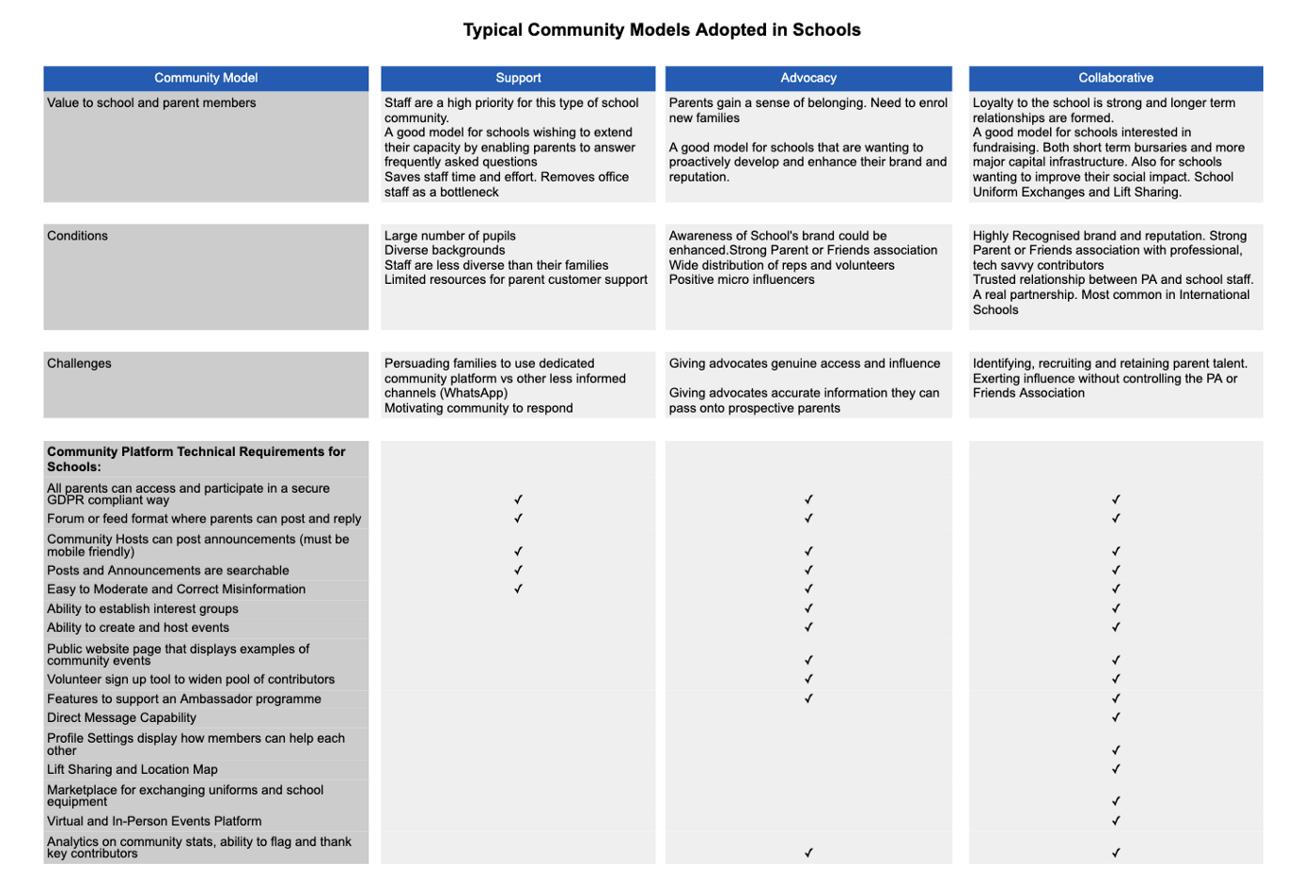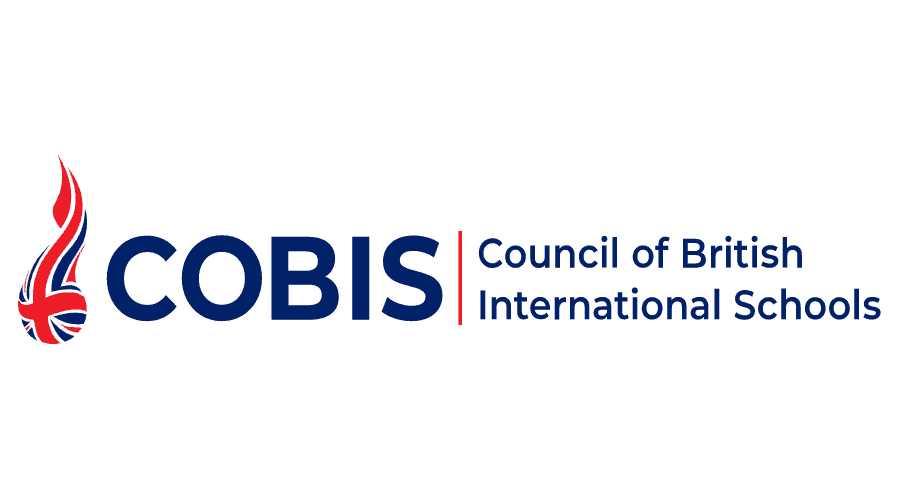Many schools spend time on developing their marketing strategy and ‘brand’. In the case of independent schools, they invest in marketing agencies to make them ‘stand out’. These agencies advise on strategy and admissions communications. The journey or life cycle of a family and key 'touch points'. Independent school marketing departments spend thousands on parent magazine advertising, editorial, digital and social media marketing to widen their reach and increase applications.
What is often missing in the case of all kinds of schools however, is the important role that current parents have in their marketing and pupil recruitment efforts. On how the existing school community can influence the recruitment, retention and referrals of families. Especially helping parents to choose your school in preference to others.
If you don’t have a community building strategy, you may very well struggle to achieve your marketing objectives.
Furthermore, if you don’t know the kind of community you’re building in your school, you’re definitely going to struggle to achieve your marketing objectives and retention goals.
What kind of school communities are there?
Although no school community is exactly the same, they tend to fall within three buckets. Each ‘bucket’ or model has certain traits. All are legitimate models. These are Support communities, Advocacy communities and Collaborative communities. The essential consideration is that the digital platform/technology solution you choose to manage and maintain your community should match your objectives. Check the table below to evaluate your type of school community.
More ambitious goals in the future
It’s worth noting that non school related businesses build two additional community models: product innovation; and best practice exchange. Clearly, there are plenty of opportunities for schools to develop their product or offer by listening to their community. There are also opportunities for parents to share best practice, particularly relating to the job of parenting. (Birthday party ideas, work experience and University applications come to mind). In reality however, we’ve seen little evidence of schools using community in these ways. Although as schools start to consider community as core to their brand management strategy we may see these models evolving in the future.
1. A well structured Support Community really saves staff time
If your school wants a support community, then creating a sense of belonging amongst its parent group isn’t a priority. All you need is an efficient way for parents to ask and answer questions. The benefit of this type of community is it operates almost 24 X 7. Parents who have been at the school for a while answer questions from new parents. Generally the questions are about logistical issues. Logistical issues around “is it this week our kids have to bring a Victoria day costume?” or” I saw something in some email at the school but I can’t find it….”
Historically your school office replies and responds to these kinds of parent queries. The school office is your help desk or support team. What the community does in this scenario is it extends the capacity of your office team. Trusted parents (often on the parent association) play a key triage role in filtering issues for the senior leadership team and school governors.
A significant topic of discussion which is a time suck for staff is — lost property. A recent Classlist survey identified that primary school teachers are rehoming items and asked by parents to locate on average seven items a week. That is time lost teaching. Schools that handle this issue well under the support community model provide a forum or place for items ‘found’ which parents can then contribute to. Importantly, these conversations are located outside the mainstream community conversations.
Besides lost property, support communities need channels. A community should be structured so parents can reach out to the smallest and most relevant group (like a class or a group of parents from the same country) for answers rather than spamming the whole community. Hence the inappropriateness of WhatsApp as a communications tool for school parents.
What is essential for this type of community is a way of moderating that is responsive but not intrusive. In our experience parents in the parent association can be very effective moderators. Particularly if parents have signed up to behavioural guidelines in advance. Usually it’s just a matter of reminding parents.
In addition, the community platform needs to have a way for parents to report a post. And if the report is valid, the offending post can be removed and the person concerned warned or suspended promptly. This needs to be done on a timely basis. Generic social networks often make this an onerous task.
How to measure the potential savings of this model?
The most common metrics:
- Case deflection. A conservative way of calculating this is by:
The number questions raised
X 15 minute time estimate
X Minimum hourly wage.
£ Value
Note: This doesn’t take into account that many of these responses are out of school office hours.
- Reduced customer support calls. This assumes that the school office is tracking and categorising calls.
- Headcount. Expected results of this model in terms of savings is at least one administrative salary per year.
2. An Advocacy Community drives up pupil numbers and parent engagement
The kind of community that this model is most likely to be relevant: an independent school that relies on fee paying pupils; or a new state school that needs to attract new pupils.
State schools don’t tend to have a marketing budget. Whereas a rule of thumb for marketing spend in the private school sector is 10–12% of income. But what is applicable to both — Word of Mouth (WOM) is the most effective way of attracting new pupils. In the case of private schools it is more cost effective than advertising open days. According to OECD and PISA data referrals from existing parents can range from 67% to over 80% of all new pupils.
One of the main advantages of using existing parents to market the school is that the conversion rate is higher than other marketing methods. Whilst schools have embraced digital marketing in the last few years, social media followers are more difficult to convert than those families that have been introduced to the school by another parent.
Parents don’t automatically become advocates however. It is happy parents that trigger this kind of organic growth.
So how do schools keep their parents happy?
Providing a fantastic educational experience is obviously paramount. Another important differentiator increasingly is about community. Post-covid it has become increasingly obvious the role that community plays in mental health. The tangible benefits of in person gatherings to wellbeing and opportunities to form meaningful relationships with each other.
Parents are happy if they can form deep and meaningful relationships with other families. Particularly if their children can make friends. Once children have friends, academic performance can become a priority.
Essential to an advocacy community is the ability for parents to connect with each other. online and in-person.
The Advocacy community platform should offer the ability for parents to join interest groups. Parents want to connect with like minded people. Parents in their children’s class AND live nearby. Parents in their year group AND like dog walking. Parents that like cycling, volunteering, AND speak different languages.
Above all this, the model should offer an event management tool. From private birthdays to larger scale summer fairs or balls. A key element of any school community event is that there are opportunities for parents to help out in some capacity. For instance running a summer stall with new acquaintances builds those kinds of healthy relationships that nurture belonging.
In addition to event management and volunteer signup features, it’s critical that the community platform identifies your advocates. We find it’s always surprises School Leadership Teams who their active advocates really are. It often isn’t the loudest parents. It’s those parents who are quietly reaching out to new parents and bringing them into the fold. A good platform will provide the analytics to see who are the network ‘nodes’ in your community, or the micro influencers, based on their reach and interaction frequency.
Furthermore, the platform should support a network of Ambassadors and advocates. Providing these individuals with extra permission levels within the platform to reach their sub-communities. For instance PTA Committees, Year Group or Class Reps fall into this category.
Once identified, recognition of their contributions is essential. Also empowering them to do more for their community. This is often a point of nervousness for school leaders but essential to creating positive advocates. You can extend your team’s reach by giving away some control. Ironically, giving them access to a moderated platform minimises the risk of your influencers operating independently, such as setting up WhatsApp groups for instance. We also recommend offering or ‘gifting’ some training (as a recognition of their contribution) to motivate advocates and to provide some checks and balances.
How to measure the return on this model?
Most common metrics:
- New parent enquiries (including data on who at the school recommended them)
- New parent joiners
- Number of events hosted by Ambassadors
- Number of event attendees
- Net promoter score/parent recommendation index*
*Sign up to our waiting list for our new feature which tracks word of mouth and the likelihood of parents recommending your school.
For schools with a close handle on their marketing data, this model should deliver a reduction in Customer Acquisition Costs or CAC. A strong community can lead to parents sending a second child to the same school, reducing CAC further. Contrary to belief, parents revisit the buying process again for second children. Especially if they don’t feel like they belong as a valued member of the school community. Certainly, the lack of in person events during the pandemic has weakened existing parent loyalty across all schools to some extent.
3. A collaborative community raises parent satisfaction
A collaborative community is an exciting one to be part of. It is most common in International and flagship schools.
Indeed, this model is most relevant to those schools (or multi-school groups) that have a strong brand and reputation. The calibre of pupils and parents is impressive. It offers a pool of talent just waiting to be tapped into. At the same time these high achieving schools are juggling a lot, so they will be looking at ways of eliminating inefficiencies and extending the reach of their marketing and pastoral teams. In particular, sharing the tasks around schooling issues that they don’t want to do. School fairs, raffles and uniform exchanges to highlight just a few examples.
In the case of a collaborative community model, the community platform must offer: tools to reduce mental load for parents and staff; and in turn, new opportunities to collaborate with other like minded people.
Parents at these schools expect communication to be filtered, relevant and mobile. They expect to receive reminders to their phone regarding important events. They expect to be alerted to events of interest to them that feed automatically into their diary. They want to access the wisdom of the community (best holiday itineraries for instance). They want to form weak and strong ties with other families. To share the school run and babysitters. They want to purchase high quality items second hand from families that have tastes similar to them. They want to volunteer in a contained way that makes the most of their knowledge and skills but doesn’t involve committing to attending committee meetings. Ideally as a consequence of this effort, enhancing their network along the way.
From the school’s perspective. Each time parents engage with the school and increase their commitment. From attending an event to helping to run one they are navigating through inner rings within the community. All good communities have inner rings that encourage their members to do more. A collaborative community needs to have a mechanism for tracking this. Additional status is unlocked as a consequence of their measurable contributions.
But for this model to work the school needs to be prepared to share information with their Ambassadors first. Such as socialising an idea or message, before it goes out to the wider audience. Being prepared to listen to feedback from their Ambassadors. Trusting them to convey messages on your behalf. Not as a way to cascade a message. More of a ‘surround sound’ approach.
Actions speak louder than words. A good community platform highlights those contributors that are answering the community’s questions, hosting events and clocking up volunteer time. It’s also possible to identify from a parent’s profile if they have particular skills or knowledge to offer the community. We find schools with effective collaborative communities are able to recruit parents to speak at careers nights or even offer pupils work experience.
And so with all these contributors, ideally a ratio of 1 contributor to 10 parents, the community isn’t just collaborative, it virtually runs itself. In international schools the contributor: consumer ratio can be as high as 30%. This is where the expectation shifts from I don’t want to be one of few to I can’t be seen not getting involved.
Further involvement, belonging, leads to schools raising substantially more funds. From events and increased loyalty towards the school. We’ve witnessed schools doubling funds raised with half the previous effort required.
Commonly, we’ve seen schools in this model proactively set up alumni groups for parents as well as pupils. This extends the lifetime value of your ‘customer’. It is helpful when you are looking for contributions towards longer term goals. Such as donations towards capital projects.
How to measure the return of this model?
- Active engagement
- Number of events hosted
- Number of event attendees
- Number of parent donors
- Number of lift shares
- Funds raised
- *Net Promoter Score or Customer Satisfaction Surveys
- Mystery shoppers
Just Different
In conclusion, we aren’t saying any of these communities are better than the other. The essential lesson here is to understand the kind of value you want to get and you want to provide for your community members. On the flip side, the community platform solution you need to implement to get the desired results.
It won’t be a surprise that Classlist is the only community platform designed especially for schools. We meet both the criteria required for all three community models.
If you would like to learn more, book a demo today.
Are you on Classlist yet?
Classlist's award-winning parent communications app is the safer alternative to public social networks. It's easy to set up! Be amongst more than 400,000 parents using Classlist in 30+ countries. Get started today!





